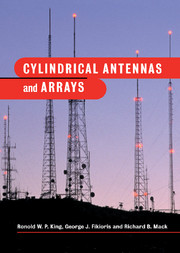Book contents
- Frontmatter
- Contents
- Preface
- Preface to first edition
- 1 Introduction
- 2 An approximate analysis of the cylindrical antenna
- 3 The two-element array
- 4 The circular array
- 5 The circuit and radiating properties of curtain arrays
- 6 Arrays with unequal elements: parasitic and log-periodic antennas
- 7 Planar and three-dimensional arrays
- 8 Vertical dipoles on and over the earth or sea
- 9 Dipoles parallel to the plane boundaries of layered regions; horizontal dipole over, on, and in the earth or sea
- 10 Application of the two-term theory to general arrays of parallel non-staggered elements
- 11 Resonances in large circular arrays of perfectly conducting dipoles
- 12 Resonances in large circular arrays of highly conducting dipoles
- 13 Direct numerical methods: a detailed discussion
- 14 Techniques and theory of measurements
- Appendix I Tables of Ψd R, T(m) or T′(m) and self-and mutual admittances for single elements and circular arrays
- Appendix II Tables of matrix elements Φu and Φυ for curtain arrays
- Appendix III Tables of admittance and impedance for curtain arrays
- References
- List of symbols
- Index
11 - Resonances in large circular arrays of perfectly conducting dipoles
Published online by Cambridge University Press: 07 August 2009
- Frontmatter
- Contents
- Preface
- Preface to first edition
- 1 Introduction
- 2 An approximate analysis of the cylindrical antenna
- 3 The two-element array
- 4 The circular array
- 5 The circuit and radiating properties of curtain arrays
- 6 Arrays with unequal elements: parasitic and log-periodic antennas
- 7 Planar and three-dimensional arrays
- 8 Vertical dipoles on and over the earth or sea
- 9 Dipoles parallel to the plane boundaries of layered regions; horizontal dipole over, on, and in the earth or sea
- 10 Application of the two-term theory to general arrays of parallel non-staggered elements
- 11 Resonances in large circular arrays of perfectly conducting dipoles
- 12 Resonances in large circular arrays of highly conducting dipoles
- 13 Direct numerical methods: a detailed discussion
- 14 Techniques and theory of measurements
- Appendix I Tables of Ψd R, T(m) or T′(m) and self-and mutual admittances for single elements and circular arrays
- Appendix II Tables of matrix elements Φu and Φυ for curtain arrays
- Appendix III Tables of admittance and impedance for curtain arrays
- References
- List of symbols
- Index
Summary
Introduction
In this and the following chapter, a study of large circular dipole arrays with one or two elements driven is presented. The top view of such an array is shown in Fig. 11.1a, and a realization of a large circular array with one element driven [1] by monopoles over a ground plane is shown in Fig. 11.1b.
The main reason for initiating the study was the belief that such arrays should possess very narrow resonances if the many parameters of the problem are properly chosen. It was further believed that some particular shapes of non-circular closed-loop arrays might produce a superdirective field pattern. The large circular array of this chapter is the simplest form of the more general closed-loop array. The latter is a subject of ongoing research.
It was seen in Chapter 4 that circular arrays of a small number of elements possess noticeable resonances; previous studies also supported the idea of the existence of very narrow resonances in large circular arrays. For instance, it was known that the long Yagi array may be thought of as a surface-wave structure [2]. Such a structure does not radiate broadside, and it was observed experimentally that this property is preserved if the array is bent into a semi-circle of sufficiently large radius [3].
Essential initial considerations concerning resonances in large circular arrays came from studies in quantum mechanics.
- Type
- Chapter
- Information
- Cylindrical Antennas and Arrays , pp. 392 - 424Publisher: Cambridge University PressPrint publication year: 2002



